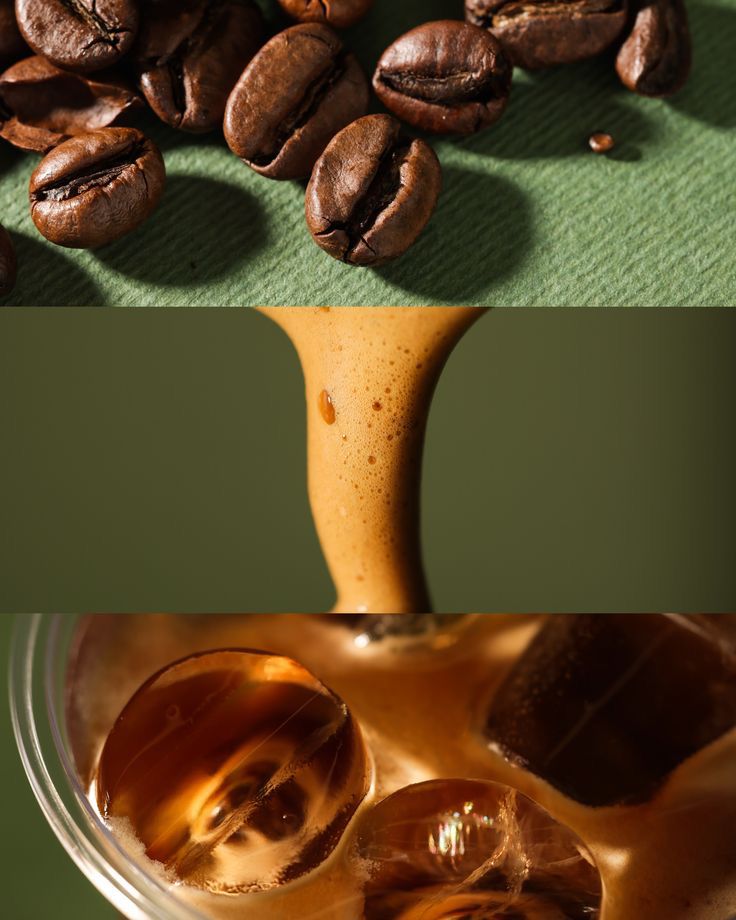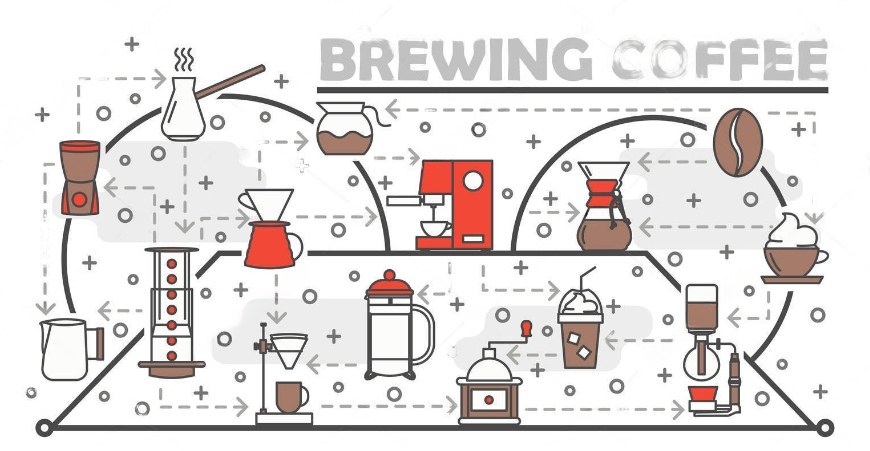أولا: المقدمة
تحضير القهوة فنٌّ بحد ذاته، وتتوفر طرقٌ لا تُحصى لإبراز أفضل نكهة في كوب قهوتك. سواءً كنت من مُحبي القهوة أو صاحب مقهى، فإنّ فهمًا أساسيًا لتقنيات التخمير المختلفة يُساعدك على تخصيص مشروبك بما يُناسب ذوقك وتفضيلاتك. في هذه المقالة، سنستكشف خمس طرق شائعة لتحضير القهوة - من آلات الضغط الفرنسية وآلات التقطير إلى آلات الصب والقهوة الباردة - لتجد الطريقة الأنسب لك.
أ. أهمية تحضير القهوة
تحضير القهوة ليس مجرد طريقة لتحضير فنجانك الصباحي؛ بل هو فرصة لاكتشاف نكهات فريدة من نوعها في حبوب البن. يتيح لك تحضير قهوتك الإبداع وتجربة طرق تحضير مختلفة، مع إضافة عناصر مثل درجة الحرارة والوقت ودرجة الطحن لتخصيص مزيجك المثالي. لا يقتصر تحضير القهوة على تحضير كوب قهوة رائع فحسب، بل يشمل أيضًا اكتشاف نكهات حبوب البن عالية الجودة واكتشاف شيء جديد في كل كوب.
ب. العلم وراء تحضير القهوة
يتطلب تحضير كوب قهوة رائع أكثر من مجرد مكونات مناسبة وجهاز تحضير موثوق؛ بل يتطلب أيضًا فهمًا دقيقًا لعلم تحضير القهوة. هناك العديد من العوامل التي تؤثر في تحضير كوبك المثالي، بما في ذلك درجة حرارة الماء، وحجم الطحن، ومدة التلامس، والتحريك؛ جميع هذه العوامل تؤثر على كيفية استخلاص القهوة من الحبوب، مما يُحدد نكهة وقوام مشروبك النهائي. إن معرفة أساسيات الاستخلاص والنكهة تُساعدك على تحسين عملية تحضيرك للحصول على خلطات أفضل في كل مرة.
ج. نظرة عامة على طرق تحضير القهوة المختلفة
تتوفر لعشاق القهوة مجموعة متنوعة من الطرق لتحضير كوب مثالي. تتميز كل تقنية بنكهاتها الفريدة وقوامها وقوتها، مما يتيح مجالاً واسعاً للتجربة. من أشهر الطرق: الصب، والضغط الفرنسي، والتحضير البارد، والإسبريسو، والإيروبريس. يساعدك فهم أساسيات كل طريقة على تحديد جهاز التحضير الأنسب لاحتياجاتك وتفضيلاتك. بالمعرفة والممارسة الصحيحتين، يمكنك إطلاق العنان لفنجان القهوة الكامن بداخلك، والاستمتاع بتجربة قهوة غامرة لا مثيل لها.
II. تحضير القهوة بالتنقيط
أ. التعريف والعملية
يُعدّ تحضير القهوة بالتنقيط من أكثر طرق تحضير القهوة شيوعًا. يتضمن ذلك سكب الماء الساخن على حبوب البن المطحونة الموضوعة في فلتر، مما يسمح بتقطيرها في إبريق أو كوب. تُوفّر هذه الطريقة طريقة سهلة وموثوقة لإعداد كوب قهوة متوازن بأقل جهد. لضمان الحصول على أفضل مذاق من فنجانك، يُمكن تعديل عوامل مثل درجة حرارة الماء، ودرجة الطحن، ووقت التلامس، والتحريك. سواءً كنت تستخدم آلة تحضير قهوة أوتوماتيكية أو آلة سكب يدوية، تظلّ القهوة بالتنقيط من الطرق المُفضّلة لتحضير كوب قهوة رائع.
ب. الإيجابيات والسلبيات
يُعدّ تحضير القهوة بالتنقيط طريقةً رائعةً لمن يبحثون عن طريقة سهلة وموثوقة. تتميز هذه العملية بتكلفة منخفضة نسبيًا، ويمكن الاستعانة بآلات آلية بسهولة. كما أنها تتيح لك التحكم في بعض المتغيرات، مثل درجة حرارة الماء، ودرجة الطحن، وزمن التلامس، والتحريك. من ناحية أخرى، ليست جميع آلات تحضير القهوة بالتنقيط متساوية؛ فقد تتطلب مهارات ومعرفة إضافية لتحقيق أقصى استفادة منها. كما أنها تتطلب إعدادًا أوليًا أطول من الطرق الأخرى، مثل آلة الضغط الفرنسية أو الإسبريسو. بشكل عام، يُعدّ تحضير القهوة بالتنقيط خيارًا مثاليًا لمن يبحث عن كوب قهوة متوازن.
ج. الاختلافات: التنقيط التلقائي، الصب
هناك نوعان رئيسيان لتحضير القهوة بالتنقيط: التلقائي والصب. تستخدم ماكينات القهوة بالتنقيط التلقائية فلترًا ورقيًا لتحضير القهوة، مع تعديلات على درجة حرارة الماء، ودرجة الطحن، ووقت التلامس، والتحريك. أما الصب، فيتطلب صب الماء الساخن يدويًا على طبقة من حبوب البن المطحونة في الفلتر. لكلتا الطريقتين مزاياها وعيوبها؛ ويختار الكثيرون إحداهما بناءً على تفضيلاتهم. وتحدد متطلبات مثل السرعة والنكهة الطريقة التي تختارها لتحضير قهوتك.
ثالثًا: تحضير القهوة بالضغط الفرنسي
أ. التعريف والعملية
تحضير القهوة باستخدام مكبس فرنسي - المعروف أيضًا باسم "إبريق المكبس" أو "الكافيتير" - هو طريقة لتحضير القهوة يدويًا تتطلب ماءً ساخنًا وحبوبًا مطحونة خشنًا. في هذه العملية، يُسكب الماء الساخن في إبريق المكبس الفرنسي ويُحرّك بمكبس قبل وضعه في الثلاجة لعدة دقائق لينقع. عند الوصول إلى التركيز المطلوب، يُضغط المكبس لأسفل لفصل التفل عن القهوة. ينتج عن ذلك فنجان قهوة غنيّ القوام بنكهة قوية بفضل زيادة وقت التلامس مع التفل.
ب. الإيجابيات والسلبيات
يقدم تحضير قهوة الـ"فرنش برس" فوائد عديدة لمن يبحثون عن قهوة غنية ولذيذة. فهي سهلة الاستخدام، ولا تتطلب سوى معدات بسيطة، وتُنتج كوبًا غنيًا وكامل القوام، محافظًا على زيوته الطبيعية. بالإضافة إلى ذلك، بفضل ترشيح البن المطحون بعد النقع، تتيح هذه الطريقة الاستمتاع بأكواب متعددة دون الحاجة إلى تغيير الفلتر في كل مرة. من عيوبها، أن تحضير قهوة الـ"فرنش برس" يستغرق وقتًا أطول من الطرق الأخرى، وقد يكون تنظيفها صعبًا للغاية بعد ذلك. كما أنها تتطلب حبوبًا مطحونة خشنة يصعب العثور عليها في بعض المناطق. وأخيرًا، نظرًا لبطء عملية الترشيح، غالبًا ما تترسب الرواسب في فنجان قهوتك.
ج. الاختلافات: Aeropress، وعاء موكا
تحتوي طريقة تحضير القهوة بالضغط الفرنسي على عدة أشكال، ولكل منها مجموعة من المزايا والعيوب.
إيروبرس هي طريقة أبسط من طريقة تحضير القهوة الفرنسية؛ إذ تستخدم كوبًا بلاستيكيًا أو معدنيًا لحمل القهوة، وفلترًا، ومكبسًا لضغطها. يوضع هذا الكوب فوق كوب فارغ، ثم تُدفع القهوة عبر الفلتر باستخدام المكبس. تُنتج هذه الطريقة قهوة أقل مرارةً نظرًا لقصر مدة ملامستها للبن، مع الحفاظ على معظم نكهتها.
إبريق الموكا: إبريق الموكا بديلٌ عن المكبس الفرنسي، وهو بديلٌ للإسبريسو، يستخدم ضغط البخار لدفع الماء الساخن عبر حبوب البن المطحونة ناعماً. هذه العملية السريعة تُنتج فنجان قهوة أقوى مذاقاً من الطرق اليدوية الأخرى. مع ذلك، ولأنها تتطلب عنايةً مستمرةً لأسبابٍ تتعلق بالسلامة، فقد تكون هذه الطريقة أنسب لصانعي القهوة ذوي الخبرة.
رابعًا: تحضير الإسبريسو
أ. التعريف والعملية
الإسبريسو نوع من القهوة يُحضّر بالضغط لإنتاج نكهة مركزة وغنية. تبدأ العملية بطحن حبوب البن إلى مسحوق ناعم، ثم تعبئتها بإحكام في فلتر قهوة لآلة الإسبريسو. ثم يُدفع الماء الساخن تحت ضغط عالٍ عبر فلتر القهوة، لينتج كوب إسبريسو صغير ذو رائحة وطعم قويين.
تتطلب هذه الطريقة قياسات دقيقة، فقلة البن المطحون قد تؤدي إلى فنجان ضعيف، بينما تؤدي كثرة البن إلى فنجان مُستخلص أكثر من اللازم ومُر. بالإضافة إلى ذلك، يجب تسخين الماء بدقة لتحقيق النتيجة المطلوبة. لهذا السبب، يُعد تحضير الإسبريسو الأنسب لخبراء تحضير القهوة أو الراغبين في تطوير مهاراتهم.
ب. الإيجابيات والسلبيات
الايجابيات:
- فهو يُنتج كوبًا غنيًا ولذيذًا من القهوة؛
- إن العملية سريعة ولا تتطلب سوى القليل من الوقت العملي؛
- يمكن استخدامه أيضًا في صنع أنواع أخرى من المشروبات مثل الكابتشينو واللاتيه.
السلبيات:
- يتطلب قياسات وتقنيات دقيقة للحصول على أفضل النتائج
- تكلفة بدء تشغيل عالية مع الحاجة إلى آلات إسبرسو باهظة الثمن
- يجب مراقبته عن كثب أثناء التخمير بسبب الضغط العالي المتضمن
ج. الاختلافات: ريستريتو، لونجو، أمريكانو، لاتيه، كابتشينو
ريستريتو: جرعة صغيرة من الإسبريسو، تستخدم نفس كمية القهوة، ولكن نصف كمية الماء المستخدمة في الإسبريسو التقليدي. ينتج عنها نكهة قوية مع قليل من الكريمة أو بدونها.
لونجو : لونجو هي جرعة طويلة من الإسبريسو تستخدم ضعف كمية المياه المستخدمة في الجرعة العادية، مما ينتج كوبًا أخف وزنًا وأقل تركيزًا مع كريمة أكثر من الريستريتو.
أمريكانو : يتم تحضير الأمريكانو عن طريق تخفيف الإسبريسو بالماء الساخن للحصول على كوب أكثر اعتدالًا يحتوي على المزيد من الجسم والنكهة من القهوة المقطرة العادية.
لاتيه : يتم تحضير اللاتيه عن طريق الجمع بين جرعتين من الإسبريسو مع الحليب المبخر أو الرغوي، مما ينتج عنه مشروب كريمي بنكهات الإسبريسو القوية.
كابتشينو : يشبه الكابتشينو اللاتيه، إلا أنه يتكون من جزء من الإسبريسو، وجزء من الحليب المبخر أو الرغوي، وجزء من الحليب الرغوي. إضافة الحليب الرغوي تمنحه قوامًا أكثر كثافة من اللاتيه، مما يجعله مشروبًا كريميًا للغاية.
الخامس. التخمير البارد
أ. التعريف والعملية
القهوة الباردة هي طريقة لتحضير القهوة تتضمن نقع حبوبها في ماء بارد أو بدرجة حرارة الغرفة لفترة طويلة. والنتيجة هي كوب قهوة ناعم وهادئ مع حموضة أقل من القهوة الساخنة. العملية بسيطة بشكل مدهش ولا تتطلب جهدًا كبيرًا: كل ما عليك فعله هو طحن حبوب طازجة مطحونة خشنًا، وإضافة ماء بارد أو بدرجة حرارة الغرفة، وتركها منقوعة في الثلاجة طوال الليل أو لمدة تصل إلى يومين. بعد انتهاء فترة النقع، ستحصل على تركيز غني وناعم بشكل رائع، يمكنك الاستمتاع به كما هو أو تخفيفه بالماء الساخن لتحضير كوب قهوة عادي. استمتع!
ب. الإيجابيات والسلبيات
القهوة الباردة طريقة سهلة ولذيذة لتحضير كوب من القهوة. إليك إيجابيات وسلبيات هذه الطريقة:
الايجابيات:
- القهوة الباردة أقل حمضية من القهوة الساخنة، مما يجعلها أسهل على المعدة.
- تنتج عملية الاستخلاص البطيئة نكهة ناعمة ويمكن تخزينها في الثلاجة لمدة تصل إلى أسبوعين، لذلك سيكون لديك دائمًا كوب منعش في متناول اليد.
- يتطلب تحضير دفعة واحدة الحد الأدنى من الجهد - فقط أضف الماء البارد إلى حبوب البن المطحونة خشنًا واتركها منقوعة طوال الليل!
السلبيات:
- يستغرق تحضيرها وقتًا أطول من القهوة الساخنة - عادةً من 12 إلى 15 ساعة للحصول على دفعة جيدة.
- يجب استخدام حبوب مطحونة خشنًا للحصول على أفضل النتائج؛ إذا لم يكن لديك حجم الطحن المناسب، فقد لا تحصل على أفضل النتائج.
بشكل عام، يُعدّ التخمير البارد طريقةً ممتازةً للاستمتاع بقهوة لذيذة دون عناء. جرّبه اليوم واكتشف لماذا يُشيد به الكثيرون!
ج. الاختلافات: القهوة المثلجة، مشروب النيترو البارد
القهوة الباردة طريقة شائعة لتحضير كوب لذيذ من القهوة، وهناك العديد من الخيارات المتاحة. إليك طريقتان من أشهر طرق الاستمتاع بالقهوة الباردة: القهوة المثلجة والقهوة الباردة بالنيترو.
القهوة المثلجة
القهوة المثلجة هي ببساطة قهوة مُحضّرة باردة، مُخفّفة بمزيد من الماء أو الحليب، ومُقدّمة فوق طبقة من الثلج. هذا الاختلاف مثالي لأيام الصيف الحارة، حيث لا تزال ترغب في الاستمتاع بمشروبك المفضل دون عناء الحرارة.
نيترو كولد برو
أما قهوة النيترو الباردة، فهي قهوة مُخمّرة باردة مُضاف إليها غاز النيتروجين. والنتيجة كوب كريمي، ناعم، وحلو، يشبه بيرة غينيس. إنها تستحق التجربة إذا كنت تبحث عن شيء جديد!
سادسا. تحضير القهوة التركية
أ. التعريف والعملية
القهوة التركية نوع من أنواع القهوة التي تُستمتع بها منذ قرون. تُحضّر بغلي البن المطحون ناعمًا في إبريق صغير مع إضافة السكر والتوابل كالهيل أو القرفة. والنتيجة فنجان قهوة قويّ وغنيّ القوام، غنيّ بالنكهة! يتضمن تحضير القهوة التركية الخطوات التالية:
- ابدأ بغلي كوب واحد (8 أونصات) من الماء البارد في قدر صغير على نار متوسطة.
- عندما يبدأ الماء بالغليان، أضيفي ملعقتين كبيرتين من البن المطحون ناعماً وحركي بسرعة حتى يصبح كل البن رطباً وموزعاً بالتساوي في الخليط.
- اخفضي الحرارة واتركي الخليط على نار هادئة لمدة 5 دقائق تقريباً حتى تتكون الرغوة في الأعلى - وهذا يشير إلى أن الخليط جاهز للخطوة التالية.
- أضف ملعقتين صغيرتين من السكر (أو أكثر، حسب رغبتك) وحرك المزيج بسرعة حتى يمتزج جيدًا. أطفئ النار واتركه لمدة 5-10 دقائق حتى تستقر أي رواسب في قاع القدر قبل التقديم.
- صبها بعناية في أكواب حتى لا تزعج أي رواسب وصلت إلى القاع؛ أضف الكريمة أو الحليب إذا رغبت واستمتع!
ب. الإيجابيات والسلبيات
للقهوة التركية فوائد عديدة، لكن لها أيضًا بعض العيوب. فيما يلي إيجابيات وسلبيات طريقة تحضيرها هذه:
الايجابيات
- كوب من القهوة قوي ولذيذ ويحمل نكهة مذهلة
- عملية التخمير السريعة والسهلة
- يمكن تعديلها حسب التفضيلات الفردية بإضافة توابل مختلفة أو مستويات من الحلاوة
- على عكس الطرق الأخرى، لا يتطلب تحضير القهوة التركية أي معدات إضافية - كل ما تحتاجه هو وعاء صغير!
سلبيات
- يتطلب التحريك والاهتمام بشكل منتظم أثناء عملية التخمير لمنع الغليان أو حرق البن المطحون
- قد يكون محتوى الكافيين في القهوة غير المفلترة أعلى من الأنواع الأخرى
- الرواسب المتبقية في قاع كل كوب عند التقديم
ج. الاختلافات: القهوة اليونانية
القهوة اليونانية نوع من أنواع القهوة التقليدية، وهي وثيقة الصلة بالقهوة التركية، مع بعض الاختلافات المهمة. تستخدم نفس طريقة غلي البن المطحون ناعمًا في إبريق مع السكر والتوابل، ولكنها تتطلب عادةً كمية أكبر من البن المطحون لكل كوب، وتكون نسبة الرغوة إلى القهوة أعلى. كما أن القهوة اليونانية أقل حلاوة من التركية، وقد يستغرق تحضيرها من خمس إلى خمس عشرة دقيقة. وبسبب هذا الاختلاف، تتميز بنكهة مختلفة عن نظيراتها التركية، مثل نكهات الجوز أو الروائح الدخانية!
٧. الخاتمة
أ. ملخص لطرق التخمير المختلفة
بعد مناقشة طرق تحضير القهوة المختلفة، مثل القهوة بالتنقيط، والقهوة الفرنسية، والإسبريسو، والقهوة الباردة، والقهوة التركية؛ يتضح أن كل شخص يستطيع إيجاد فنجان القهوة المثالي له. مهما كانت الطريقة التي يختارها، فإن كل طريقة تتميز بنكهاتها الفريدة وتعقيداتها. سواءً فضّلوا القهوة الفرنسية الكلاسيكية أو قهوة عصرية مثل الإسبريسو، فهناك خيارات عديدة لتحضير فنجانهم المفضل كل صباح!
ب. العوامل التي يجب مراعاتها عند اختيار طريقة التخمير
عند اختيار طريقة التخمير الأنسب لك، من المهم مراعاة تفضيلاتك وأسلوب حياتك. هل تفضل مشروبًا أقوى أم أكثر رقة؟ هل لديك الوقت الكافي لعملية استخلاص بطيئة وطويلة، أم تحتاج إلى طريقة سريعة؟ وأخيرًا، ضع في اعتبارك تكلفة كل طريقة؛ فبعضها يتطلب معدات إضافية، مثل آلة الإسبريسو أو المكبس الفرنسي. بمراعاة جميع هذه العوامل، يمكنك اختيار طريقة التخمير المثالية لك!
ج. الأفكار النهائية والتوصيات.
باختصار، هناك طرق عديدة لتحضير القهوة، ولكل منها نكهات وروائح مميزة. ومع ذلك، أيًا كانت الطريقة التي تختارها، من المهم مراعاة الوقت والتكلفة والجهد المبذول قبل اختيار إحداها. يكمن جمال القهوة الحقيقي في إمكانية تجربتها! فلا تتردد في تجربة طرق مختلفة لتجد فنجانك المثالي - فالاحتمالات لا حصر لها!
سادسا. موارد إضافية
أ. ماركة القهوة الموصى بها
لمن يبحث عن أفضل أنواع القهوة وطرق تحضيرها للاستمتاع بفنجان قهوته اليومي، تفضلوا بزيارة متجرنا لتجربة قهوة رائعة. كما نوفر آلات قهوة ، مطاحن ، وأدوات تحضير .
ب. المجتمعات والمنتديات عبر الإنترنت لمحبي القهوة
بالنسبة لأولئك الذين يبحثون عن مجتمع عبر الإنترنت لمشاركة تجاربهم ومعرفتهم بالقهوة مع الآخرين، فهذه بعض من أفضل الخيارات.


